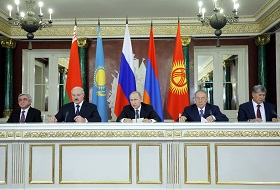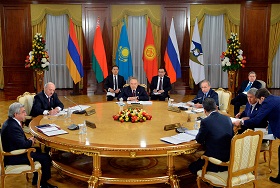The Marginalia of Russia’s Foreign Policy Today
(votes: 2, rating: 5) |
(2 votes) |
PhD in Political Science, RIAC Expert
Russia’s integration into global and regional political and economic institutions, as well as the desire to restore its positions in significant regions around the world still has not led to the shaping of a comprehensive strategy regarding its closest neighbours, that is, in relations with the former Soviet countries. For the most part, these countries remain outside the scope of Russia’s active foreign policy; Russia’s political elites perceive them as partners “by default,” as a priori economically dependent entities. The article discusses the current possibilities that Russian diplomacy could use in its relations with former Soviet countries to shape a politically loyal and economically predictable border zone.
The strengthening of Russia’s positions in the international arena as a result of its integration into global and regional political and economic institutions, as well as the desire to restore its positions in significant regions around the world still has not led to the shaping of a comprehensive strategy regarding its closest neighbours, that is, in relations with the countries of the former Soviet countries. For the most part, these countries remain outside the scope of Russia’s active foreign policy; Russia’s political elites perceive them as partners “by default,” as a priori economically dependent entities.
The author proposes applying a metaphor of “marginalia” to this group of countries; they are significant from both the political and economic points of view, yet they are not among the priorities of Russia’s real foreign policy efforts. No comprehensive work is being carried out with these countries; there is no long-term planning regarding them. The lack of goal-setting with regard to these countries leads to the fact that Russian diplomacy has to react to the signals already coming from in the former Soviet countries; Russian diplomacy does not independently shape its foreign policy in this area. At the same time, Russia’s desire to be an equal partner for the key world actors cannot be implemented without ensuring a loyal and friendly geopolitical environment. One of the measures to form such an environment is the creation of the Eurasian Economic Union (EEU). Today, however, given the economic instability and escalating external threats, this institution requires greater attention and work on a future-oriented strategy. This article discusses the current possibilities that Russian diplomacy could use in its relations with former Soviet countries to shape a politically loyal and economically predictable border zone. In its methodology, the article relies on comparative analysis, document analysis and case studies.
In the course of the research, groups of medium-term goals for Russia’s foreign policy regarding its closest neighbours were developed; the article also developed recommendation for optimizing Russian strategy in the post-Soviet space.
Russia’s Strategy for Interacting with Neighbouring Countries
The societies of these new states are entering a stage where those who were born in new political circumstances dominate the social landscape. The fight to win the minds of these people is on. For Russia, it is important not to lose the productive component of its image as the successor of the large country.
Since Primakov’s famous “U-turn over the Atlantic,” Russian diplomacy has had a great deal of success in global politics. And the early 2010s were no exception. Russia fully demonstrated foreign policy features: multi-vector nature, support for the multilateral diplomacy institutions, and a desire to develop a dialogue with the world’s leading states. Some of the more glaring examples are the Strategic Offensive Reductions Treaty and the Treaty signing between the United States of America and the Russian Federation on Measures for the Further Reduction and Limitation of Strategic Offensive Arms (the New START Treaty), Russia’s participation in the negotiations on the destruction of Syria’s chemical weapons, and its support of the negotiation process on Iran’s nuclear programme.
The list could go on. But one thing is already clear: all these successes apply to countries and regions that are fairly distant geographically. This is easily explainable, since Russia is a world power, involved in solving problems of the world’s political development. However, Russia’s relations with its immediate neighbours have remained outside the scope of these developments. The achievements of Russian diplomacy in this area have rarely been cause for foreign policy pride. For any country (and world powers are no exception here), reliable, friendly and constructive relations along their borders are a guarantee of successful development.
The picture started to change in response to the increasing political dialogue between Russia and China, and also to the (EEU) becoming fully operational. This shift of focus in Russia’s foreign policy toward its neighbours must be considered separately.
Since the geopolitical space of the former Soviet Union began to develop, there was the notion that Russia’s near-abroad was a region where certain political and economic developments occur by default in the most-favoured-nation regime. Such a conceptual vision was begotten by the belief that, over the years of living together in the USSR, Russia had formed fairly stable ties with the republics, including stable industrial and economic and infrastructural chains, and well-established research, development and production ties. Accordingly, even when developing independently, former Soviet republics were supposed to gravitate toward each other on the basis of the already-formed common manufacturing needs and humanistic space. Hence, the invariable mentions of the post-Soviet space as a priority of Russia’s foreign policy concepts. However, over the years, a special strategy aimed at developing ties with “new” neighbours under the new conditions of global development and open international competition for resources has failed to materialize. All the suggestions about developing relations with the former Soviet republics remained a sort of marginalia, notes in the margins of Russia’s foreign policy that had not been put together into a logically structured multilevel system of interactions. Influenced primarily by external challenges, Russia is currently revising its relations with its closest neighbours in favour of creating more pragmatic ties.
In order to increase the efficiency of Russian foreign policy, especially in its relations with its neighbours in the former Soviet Union, a strategizing element must be introduced.
This raises a series of strategic questions, the answers to which will allow us to assess the stability of foreign policy relations along the Russian Federation’s border.
Firstly, will the status of the neighbouring post-Soviet states increase in terms of Russia’s real foreign policy framework?
Secondly, can Russia fully restore its relations with all the CIS countries? Thirdly, is it expedient for Russia to develop a clear strategy of interaction with its neighbouring countries?
Without finding the answers to these questions, it is hard to imagine an efficient foreign policy for Russia.
Development Potential and Conflict Potential
The differences that exist between the former Soviet countries pose a significant challenge for Russia itself. The states are different in terms of economic and societal structures, the historical conditions of shaping bilateral relations with Russia, and the participation of the countries in various international organizations, unions and alliances. All these factors leave their footprints on Russia’s relations with its neighbours.
Today, joint work on infrastructural projects, including developing power grids, constructing highways and railways and the related infrastructure could bring best results./blockquote>
Simple analysis demonstrates that Russia’s geopolitical contours are rather imbalanced. If we take Russia’s common border with new states that have emerged within former Soviet countries, even such an indicator as length will vary from 70 kilometres with South Ossetia and over 7,500 kilometres with Kazakhstan.
Given such heterogeneity, is it even possible to form a common strategy for interacting with neighbouring countries? However, understanding Russia’s fundamental tasks in its relations with the neighbouring post-Soviet states helps formulate the principal approaches to the strategic and comprehensive interaction with them.
The first group of tasks is connected with preserving and strengthening Russia’s bilateral diplomatic relations with its neighbours. By the second decade of the 21st century, implementation of this task had moved from merely maintaining connections to “playing on multiple boards at once.” After the Russia–Georgia conflict in August 2008, Russia acquired two new foreign political partners: South Ossetia and Abkhazia, losing direct diplomatic contacts with Georgia. A formal, even mathematical, approach to this issue would state that the number of states with which Russia has diplomatic relations grew by one. In terms of the goals of the “Foreign Political Activity” state program of the Russian Federation, this is a positive result.[1] However, the task of maintaining previously established connections turned out to be more difficult in case of Georgia.

Ivan Timofeev, Elena Alekseenkova:
Eurasia in Russian Foreign Policy:
Interests, Opportunities and
Constraints
Since 2014, Russia–Ukraine relations have been extremely tense. Today, they are far from the understanding stipulated in the 2013 Concept of the foreign policy of the Russian Federation: “…build up relations with Ukraine as a priority partner within the CIS, contribute to its participation in extended integration processes.”[2] The unresolved issue of South-East Ukraine and the fact that the international community does not recognize Crimea as a legal entity of the Russian Federation escalate tensions on the Russian borders.
In this connection, Russia’s primary task is to have its borders legally confirmed and to solve territorial disputes. Guided by this goal, in the 2000s, Russia signed (fine-tuned or exchanged instruments of ratification) a series of treaties (or agreements) related to its borders, and not only with the newly independent states, but also with: Lithuania (2003); Kazakhstan (2005); China (2005); Latvia (2007); Azerbaijan (2011); Norway (2011); and Estonia (2014).
The full implementation of this task has a direct impact on the subsequent resolution of issues connected with the functioning of customs services and the intensity of the border-zone activities.
In order to form Russia’s foreign political strategy, it is necessary to create and promote an open database of legal information that reflects the development of Russia’s relations with its neighbouring states.
The second group of tasks inolves specifying the international subject status and state identity of the countries that declared their independence 25 years ago after the dissolution of the USSR. The actions of Russia’s new neighbours were directed primarily at establishing their selfhood and refusing to support the past Soviet experience, including the objective factors of their infrastructure and industries having been built through the efforts of the entire USSR. To realize their desire for independence, they select the strongest foreign economic partners. The goal of such partnerships is to ensure a country’s guaranteed socioeconomic development, while retaining the specific features of forming the political elite. This approach essentially disregards profound cultural and family ties and the powerful civilizational influence of the Russian language, as well as Russian science on all the former Soviet states.
The struggle in these countries against such developments produces a particularly stark emotional reaction and hinders productive dialogue.
It has become more and more difficult to rely on the historical memory of the generations that lived and worked in the USSR. The societies of these new states –former Soviet republics – are entering a stage where those who were born in new political circumstances dominate the social landscape. The fight to win the minds of these people is on. For Russia, it is important not to lose the productive component of its image as the successor of the large country. Here it is also important to preserve comprehensive support for projects aimed at maintaining interest in studying the Russian language, which opens a wide range of opportunities for developing cognitive activities. While statehood is still being formed within the post-Soviet space, it is still difficult to predict the results of this process, and the most effective tactic is to strengthen bilateral interactions with the new neighbouring countries while continuing to work actively on preparing and implementing a more general strategy regarding those states.
The third group of tasks is linked to developing multilateral regional institutions and forming responsibility with regard to common processes in politics and economics. Serious thought is required here to resolve the problems realated to implementing large-scale economic initiatives and regional security projects. It is obvious even now that the CIS, as an economically driven project, is facing greater and greater geopolitical challenges with regard to state security. For the same reasons, the possibility of including the Shanghai Cooperation Organisation (SCO) in the project to tie the EEU and China’s Silk Road Economic Belt (SREB) project together are being discussed. The question of the role of the Collective Security Treaty Organization (CSTO) is, therefore, logical.
At the same time, stability within the CIS is guaranteed by maintaining an intensive regional dialogue on all the challenges and threats common to the entire space of the newly independent states. These threats and challenges are, above all, drug trafficking, Islamic radicalism, terrorism and smuggling. It is hardly possible to name a country in the region that does not have to deal with at least two or three of these problems.
Currently, all the new tasks in this group remain the “marginalia” of Russia’s foreign policy. There is an understanding, but no clear vision – as there are no clear approaches to solving these problems, there is no comprehensive strategy. It should be noted that such a situation cannot continue forever; the development of each separate country and its surroundings will force certain decisions to be made. It is important to be ready to anticipate major changes that affect Russia’s interests, and to respond to them in a timely manner.
Recommendations on Shaping the Russian Strategy of Relations with Other Countries
Given the current crisis in Russia’s relations with Europe and the United States, the logic of “one-day planning” gains momentum. Tactical steps are being actively discussed, and the measures already taken are having a visible and tangible effect. Unlike the western elites, who think in the categories of linearity and predictability, Russian leaders master their skills using the tactics of “delayed action” and “accurate response.” Long-term planning, on the contrary, appears difficult and little in demand among decision-makers. That leads to reactive policies dominating over pro-active steps. In order to increase the efficiency of Russian foreign policy, especially in its relations with its neighbours in the former Soviet Union, a strategizing element must be introduced. Advice from the outside will hardly help Russia to overcome the difficulties that have emerged in relations with its neighbours. A unique combination of geography and cultural and historical ties makes interaction between bordering countries inevitable.
What approaches could be adopted in this case?
One of the key approaches must be formulating strategies for interacting with neighbouring states. This could be done by developing a foreign policy strategy for all the new neighbours, as well as for groups of countries or a region; alternatively, it could touch upon individual interaction aspects, for instance, humanistic or border-zone cooperation. Certain steps in this direction have already been taken. The legal foundations for such documents were laid down in Federal Law 172-FZ “On Strategic Planning in the Russian Federation,” dated June 28, 2014.[3] What is more, Russia’s border-zone regions could successfully participate in implementing this task. On the whole, it would appear to be a productive course of action if efforts aimed at strategizing relations with neighbouring countries could be distributed between all the interested parties in Russia.

Vyacheslav Sutyrin:
“A Thousand Threads” Policy:
Russia’s “Soft Power” in the
Post-Soviet Space
Implementing this approach is closely linked with resolving the tasks of making Russia’s relations with its neighbours progressively more pragmatic and defining Russia’s interests in each bordering state. Forming a kind of a “matrix” of interests would allow for resources to be used more efficiently and promising lines in regional cooperation to be defined. Today, when more and more attention is being paid to tying together the EEU and the SREB, joint work on infrastructural projects, including developing power grids, constructing highways and railways and the related infrastructure could bring best results.
Special attention should be paid to setting up active monitoring of possible processes in the neighbouring states. Today, there is no shortage of organizations that are ready to provide this kind of information. Such work could be done ad hoc, at the request of the interested state or commercial bodies. The Russian International Affairs Council (RIAC) held its summer school “The Situation in Central Asia: Security, Economy, Human Development,” which could serve as an example of developing such situational scenarios.[4] Its participants – young experts – created scenarios of Central Asia’s development after NATO’s withdrawal from Afghanistan. The key problem of such analytical products is promoting them: getting high-level politicians to consider them as a matter of “FYI,” discussing them at expert meetings, getting them covered by both traditional and online media.
A more positive attitude to the monitoring results could be adopted as well. Periodical cross-sections of information, particularly when presented as statistical data, have a greater chance of becoming a necessary argument in political decision-making. Yet such information will be of power only if there is an algorithm for both collecting it from reliable sources and processing it.
Taking these assumptions into account, it would be correct to say that, in order to form Russia’s foreign political strategy, it is necessary to create and promote an open database of legal information that reflects the development of Russia’s relations with its neighbouring states. Currently, this information exists in bits and pieces and is not always complete and timely. It appears that the best solution would be to upload the texts of agreements signed between Russia and its neighbouring countries on the Ministry of Foreign Affairs of the Russian Federation website and update this section regularly. Such an approach would provide the expert community with a reliable basis for assessing the effectiveness of the measures being implemented and creating new strategies for developing relations with bordering countries.
Focusing Russia’s attention on developing a strategic approach to neighbouring countries agrees both with the incontrovertible logic of geographic proximity and with the processes in the post-Soviet space. Today, experts note a growing trend of moving away from the notion of “post-Soviet states” [1]. This is connected with international economic processes shaped by large global and regional powers making active inroads into those countries. Simultaneously, the search for identity among the new states is under way, and the desire to strengthen this identity is clear. Against the background of these processes, it is important for Russia to formulate a multilevel strategy of relations with new bordering states.
First published in the journal Humanities and Social Sciences. Bulletin of the Financial University. 2016 (1).
REFERENCE
1. Markedonov S.M. Goodbye Post-Soviet Space? // URL: /en/inner/?id_4=7015#top-content (retrieved on January 31, 2016)
[1] Foreign Political Activity Russian State Programme. URL: http://www.mid.ru/foreign_policy/official_documents/-/asset_publisher/CptICkB6BZ29/content/id/698403 (retrieved on January 31, 2016)
[2] Concept of the Foreign Policy of the Russian Federation (approved by President of the Russian Federation V. Putin on February 12, 2013). URL: http://www.mid.rU/foreign_policy/official_documents/-/asset_publisher/CptICkB6BZ29/content/id/122186 (retrieved on January 31, 2016).
[3] URL: http://www.rg.ru/2014/07/03/strategia-dok.html (retrieved on January 31, 2016)
[4] Central Asia after the Withdrawal of Coalition Forces from Afghanistan: Prediction Scenarios 2014–2024. URL: /inner/?id_4=1870#top-content (retrieved on January 31, 2016).
(votes: 2, rating: 5) |
(2 votes) |






